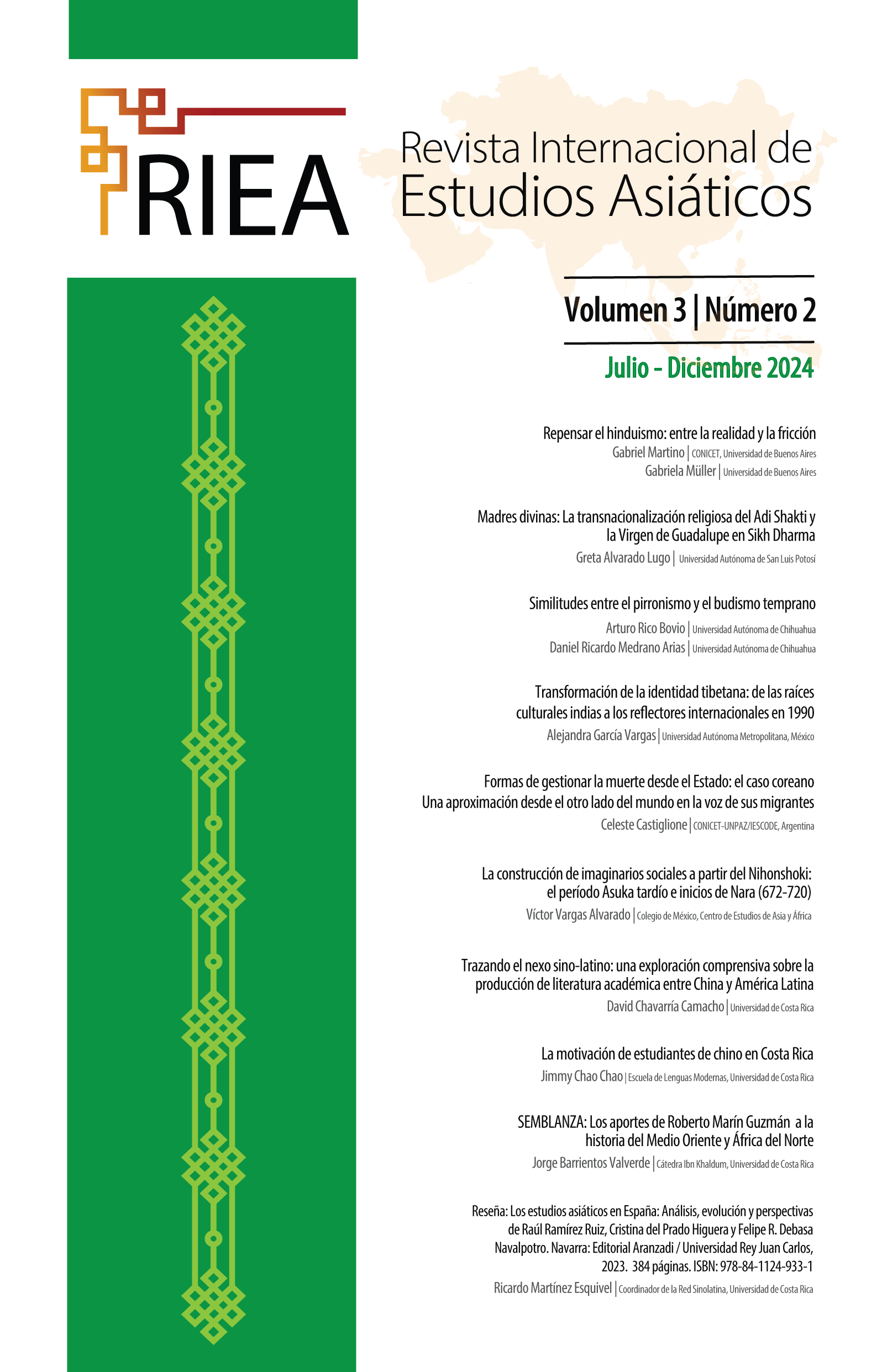Abstract
In this paper, I explore monographically the historical relationship between India and Tibet through different periods, which gave rise to various Tibetan cultural expressions with a strong Indian influence, such as folk music, painting, theater, writing, and religion. Subsequently, an analysis of the Western construction of Tibet is presented. Considering the experience of the encounter between Indian culture and the West, with both regions continually mentioned together, surrounded by an aura of mysticism and spirituality, being the setting for myths such as the giant ants of the Indus region or the journeys of Jesus of Nazareth. During the 1970s, through the New Age movements, both societies had a strong impact on the Western and Chinese societies, becoming part of popular culture due to their presence in the media, series, movies, and influencing music of that decade.
References
Asia Society. «Tibetan Monks Perfom “Sacred Music Sacred Dance for Word Healing” at Asia Society Texas Center on August 20». Asia Society (2016). https://asiasociety.org/texas/tibetan-monks-perform-%E2%80%9Csacred-music- sacred-dance-world-healing%E2%80%9D-asia-society-texas-center-augu.
Attisani Antonio. «Aspects of the Tibetan Theatre Question». The Tibet Journal 30, n.° 1 (2005): 3–60. http://www.jstor.org/stable/43301112.
Carralero Benítez, Santiago José. Paisaje tras la Catástrofe. Un relato de nómadas en transición del Tíbet oriental. (Andalucía: YURTA Association: Centro de Conocimiento Pastoril, 2022).
Chinlei Jampei, trad., Cristina Roque Sainero, «El budismo tibetano», en TIBET, (Madrid: Editorial Libsa, 1990), 159-160
Dodin Thierry y Heinz Räther. Imagining Tibet: Perceptions, Projections, and Fantasies. Boston: Wisdom Publications, 2001.
Frangville, Vanessa. «Tibet in Debate: Narrative Construction and Misrepresentations in Seven Years in Tibet and Red River Valley». Transtext(e)s transcultures. Journal of Global Culture Studies 5, (2009) https://journals.openedition.org/transtexts/289
Grimes, Samuel. «Where Did “Tibetan” Singing Bowls Really Come From. Beyond the mystique lies a complicated history». Tricycle: The Buddhist Review (march 2020). https://tricycle.org/article/tibetan-singing-bowls/
Gyatso Tenzin y Chodron Thubten. «Origen y difusión de la doctrina del Buddha». En Budismo. Un maestro, muchas tradiciones. Traducido por María Tabuyo y Agustín López, 21-33. Barcelona: Herder Editorial, 2016.
Hansen, Peter H. «The Dancing Lamas of Everest: Cinema, Orientalism and Anglo - Tibetan Relations in 1920s». The American Historical Review 101, n°3 (1996): 712-747. https://doi.org/10.2307/2169420.
Henrion-Dourcy, Isabelle. «Women in the Performing Arts: portraits of Six Contemporary» Singers. Women in Tibet. Editado por Janet Gyatso y Hanna Havnevik, 195-259. London: Hurst and Co. 2005. https://www.researchgate.net/publication/313037187_2005_Women_in_the_Performi ng_Arts_portraits_of_Six_Contemporary_Singers
Li, Mingdi. «El Turismo Religioso Y Peregrinaciones: Análisis Cualitativo Para Un Caso De Estudio Del Camino Del Tíbet». Journal of Tourism Analysis: Revista De Análisis Turístico 29, n.°1. (2022): 1-35. https://doi.org/10.53596/jta.v29i1.371.
Lopez, Donald. Prisoners of Shang Ri-La: Tibetan Buddhism and the West. Chicago and London: University of Chicago Press, 1999.
Morcom, Anna. «Locating music in capitalism: A view from exile Tibet». Popular Music 34, n.° 2 (april 2015): 274-295. http://www.jstor.org/stable/24736912.
Morcom, Anna. «The Political Potency of Tibetan Identity in Pop Music and Dunglen». Himalaya 38, n.° 1 (2018): 127- 144. https://digitalcommons.macalester.edu/himalaya/vol38/iss1/16
Mondragón, Carlos. «El Tíbet Chino: Crecimiento económico con exclusión étnica».
Foreing Affairs Latinoamérica (julio 2016). https://revistafal.com/el-tibet-chino/.
Morning Edition. «Gyuto Monks: Ancient Practice, Modern Sound». National Public Radio, (2009). https://www.npr.org/2009/03/24/102234687/gyuto-monks-ancient-practice- modern-sound
Nochlin Linda, «” The Imaginary Orient”, The politics of Vision: Essays on Nineteenth-Century Art and Society», Routledge – Publisher of Professional and Academic Books, London, 1989, p.35-59.
Powers John y David Templeman. Historical Dictionary of Tibet. Lanham, (Maryland: Scarecrow Press. 2012), 630
Qian, Lijuan. «Humanism in Red: A New Mainstream Narrative in the Pop Songs in 1980s' China». Oxford Handbookof The Music in China. Oxford: Oxford University. 2021 https://www.authorea.com/doi/full/10.22541/au.161739401.16499921
Roger R. “Poesía en el Tíbet”, Periódico de Poesía, n.°16. Traducción de Angélica Maciel, febrero de 2018, http://www.archivopdp.unam.mx/index.php/5078.
Sadiksha. «Drepung Loseing Monastery in India». Mandalas Life Nepal (october 2018). https://mandalas.life/2018/drepung-loseling-monastery-in-india/
Said Edwin, “Conocer lo Oriental” en Orientalismo, trad.María Luisa Fuentes, (Barcelona: Random Hpuse Mondadori, 2008) 57-80. Edición PDF https://hemerotecaroja.files.wordpress.com/2013/06/said-e-w-orientalismo-1978-ed- random-house-mondadori-2002.pdf
Shakya Tsering Wangdu. «Tibetan Questions». New Left Review, n.°.51, (may- june 2008). https://newleftreview.org/issues/ii51/articles/tsering-shakya-tibetan-questions
Shakya, Tsering Wangdu. « ‘Wither the Tsampa Eaters?’ ». Himal: Southasian (1993). https://www.himalmag.com/whither-the-tsampa/
Stephen Jones. «Women in Tibetan expressive culture». Stephen Jones: a blog (august 2020). https://stephenjones.blog/2020/08/21/women-in-tibet/
Usborne, Simon. «The incredible life of a monk who fled Communist China and now runs a monastery in Dumfries».iNews (2020).https://inews.co.uk/inews- lifestyle/people/lama-yeshe-losal-rinpoche-interview-tibetan-monk-fled-communist- china-monastery-scotland-615138
Yeh, Emily T. «Capítulo 2. Indigeneidad tibetana: traducciones, semejanzas y acogida». En Indigenidades contemporáneas: cultura, política y globalización. Edición de Marisol de la Cadena y Orin Starn, 83-113. Lima: Institut français d’études andines, Instituto de Estudios Peruanos. 2010. https://books.openedition.org/ifea/6228
Yerushalmi Dan, «Bell Envy», TIBETO-LOGIC, https://tibeto-logic.blogspot.com/2009/06/bell-envy.html, June 15 2009
Yerushalmi, Dan. «Efficacy of the Living Dam». TIBETO-LOGIC (october 2018). https://tibeto-logic.blogspot.com/2018/09/efficacy-of-living-dam.html
Yerushalmi Dan. «God Digging Ants of Herodotus Part 1». TIBETO-LOGIC (february 2019). https://tibeto-logic.blogspot.com/2019/02/gold-digging-ants-of-herodotus-part- 1.html.

